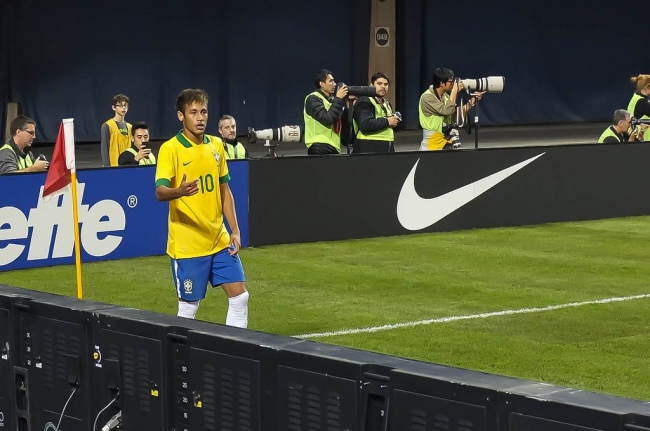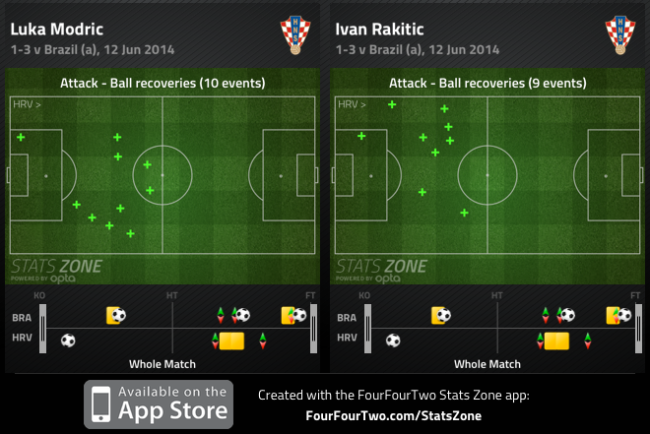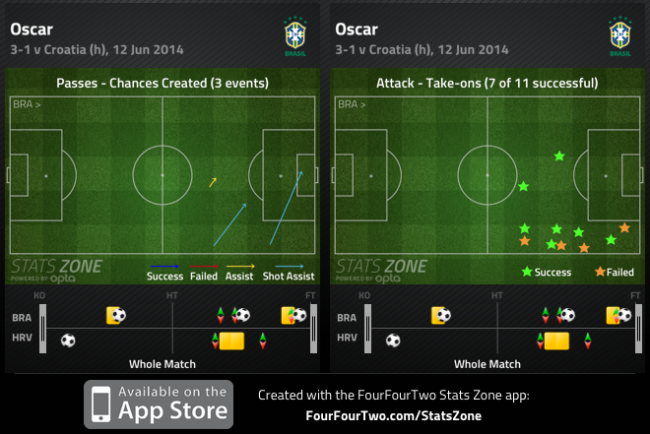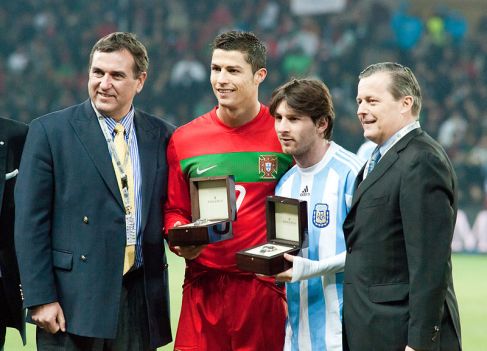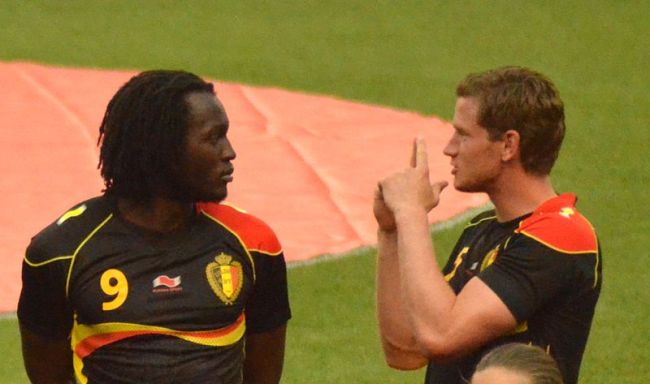Neymar scored twice as Brazil came from behind to defeat Croatia in the opening match at the World Cup.
Luiz Felipe Scolari fielded his expected starting XI with Fred leading the line ahead of Neymar, Oscar and Hulk. Luiz Gustavo and Paulinho started in the double-pivot.
Without the suspended Mario Mandzukic, Niko Kovac was forced to start Nikica Jelavic upfront ahead of Ivica Olic, Mateo Kovacic and Ivan Perisic. Talented midfielders Luka Modric and Ivan Rakitic formed a midfield duo in Kovac’s 4-2-3-1.
Croatia enjoyed a positive opening 15 minutes before Oscar stamped his authority on the match. However, a poor decision by the referee tilted the momentum in Brazil’s favour, and the hosts dealt with Croatia’s late onslaught.
Croatia’s defensive approach
The key to Croatia’s shape in the opening minutes was partially based around their shape. Kovac’s decision to field three ball-playing midfielders led many to believe that Croatia would attempt to control the match. Croatia, however, maintained a medium defensive block, as they dropped into two banks of four without the ball.
Kovacic and Jelavic sat off the Brazilian centre backs and positioned themselves ahead of Luiz Gustavo and Paulinho to cut off passing lanes into midfield. The Brazilian duo was forced to play conservative passes into wide areas, and Kovac’s pragmatism ensured that Croatia negated one of Brazil’s main strengths.
Perisic and Olic – two wide forwards – tirelessly pressed Marcelo and Dani Alves and prevented the full-backs from pushing forward. Considering Marcelo and Dani Alves’ offensive impact in the Confederations Cup, Kovac’s decision to instruct his wingers to limit their threat was pivotal.
Croatia’s approach without the ball was logical, and equally effective in the opening period.
Croatia attacks
Croatia surprisingly took the lead in the opening 10 minutes courtesy of a Marcelo own goal, but the goal and a previous opportunity followed the same pattern.
Modric ignited the break from midfield before playing a pass to Perisic on the right flank, and the Croatian winger’s cross towards the back post saw Olic out jump Alves and steer his header inches wide of the post. Subsequently, Rakitic’s ball to Olic on the left flank led to Jelavic guiding the Croatian winger’s cross off Marcelo and into the net.
There was always space behind Alves and Marcelo as they continuously aimed to maraud forward, thus leading to the duo conceding possession and being caught out of position. Equally, Croatia aimed to use their wide players’ physical presence to outmuscle Brazil’s diminutive full-backs. Along with Olic’s early chance, Perisic received a cross from Jelavic, and out jumped Marcelo, but he guided his header directly at Julio Cesar.
Croatia’s intelligent midfielders quickly transitioned into attack when they won possession, and exploited the physical and positional deficiencies of the Brazilian full-backs.
Oscar
Scolari’s men were poor in the opening 15 minutes, and their shape was often disjointed when they were in possession. Brazil required a link between midfield and attack, as Neymar was forced to drop too deep to receive the ball, while the midfielders couldn’t facilitate passes towards the wide players and Fred.
Oscar’s start to the match was quite shaky, but he did play two good crosses into the box that shouldn’t be overlooked. The Brazilian continued to take advantage of Vrsaljko – who isn’t a natural left-back – by pushing the ball towards the byline to earn a corner and delivering a cross into the six-yard box that evaded both Neymar and Fred.
Most of Oscar’s play continued down the right; his curling effort following Neymar’s magic was pushed aside by Pletikosa, and he played a great ball into Paulinho between the lines, but the midfielder’s shot was saved by Pletikosa. Oscar usually moves to the right to create space for his teammates, but here he served as the link that Brazil required. Oscar was equally impressive on the defensive end as he protected his full-backs out of possession, and completed key tackles in midfield to halt Croatia’s breaks on the counterattack.
Likewise, the Chelsea man was involved in all three Brazilian goals. His persistence in a challenge against Rakitic and Modric enabled the Chelsea midfielder to break free and flick the ball to Neymar who opened the scoring. Oscar impressively ran past Vrsaljko and Marcelo Brozovic and played a great pass into Fred, which resulted in the referee harshly awarding a penalty to Brazil for Dejan Lovren’s non-foul on Fred. Lastly, Oscar received a loose ball and capped off his tremendous performance with a low shot past Pletikosa to double Brazil’s lead.
Oscar nearly created another goal from the right flank as his cross into the box to an unmarked David Luiz was steered wide of the net. Oscar was undoubtedly the best player on the field, and oddly it was from the right flank – a position he isn’t naturally accustomed to playing – as he was the catalyst in Brazil’s comeback with his deliveries from wide areas, clever passes, and tireless work rate.
The 22-year old displayed why many classify him as Brazil’s most important player.
Second half
Prior to Neymar’s controversial second goal, Brazil continued to struggle as a unit. Their passing tempo was vividly slow, and Croatia did a better job in attempting to nullify Oscar’s threat. Croatia dropped a bit deeper in the second half, but continued to exploit space behind Alves and Marcelo.
On a few occasions Olic and Perisic broke into space behind the full-backs, but their poor final ball was often cleared, and Thiago Silva and David Luiz made several timely last-ditch clearances and tackles. Perisic, in particular, enjoyed a good game with his admirable defending, reliable passing, along with his pace and power to drive forward down the flanks. Rakitic and Modric saw more of the ball in the second half as players tired. Oscar and Gustavo harried the latter in deep areas, and without Neymar closing down Rakitic, the Sevilla midfielder began to string positive passes forward.
The match lacked many clear-cut chances apart from the goals and the managers’ attempt to alter the match via substitutions were futile. Scolari’s decision to introduce Hernanes was logical – he’s a good passer of the ball and could quickly increase the passing tempo – but the Inter Milan midfielder was ineffective. Bernard’s direct threat injected energy but he didn’t offer much going forward, while Ramires’ short cameo led to Oscar’s third goal.
Marcelo Brozovic’s presence did offer another threat upfront, as he remained higher up the pitch, and although Ante Rebic offered mobility, he failed to influence the match.
The match opened up in the final 15 minutes with Neymar receiving plenty of space between the lines to drive forward, but Brazil didn’t test Pletikosa. Scolari’s men preferred to drop into their shape to preserve the lead, but Croatia’s persistence led to Modric and Perisic’s efforts from distance – that Cesar poorly dealt with — and Cesar’s controversial collision with Olic.
Conclusion
Croatia will feel robbed of a potential point following an effective display prior to Neymar’s second goal. However, Oscar’s well-rounded performance along with Pletikosa’s poor goalkeeping also contributed to Brazil’s success on the night.
Kovac’s men did a great job without the ball in negating Brazil’s full-backs and equally exploiting space behind the attack-minded defenders, but they didn’t create enough chances and their final ball was poor.
This wasn’t a great Brazilian performance, but to some degree this is what to expect from Scolari’s men. Brazil is a highly functional side that may not play the most attractive football in the tournament, but they possess a quality that majority of the teams in the tournament lack.
They know how to win games.
